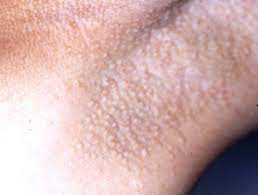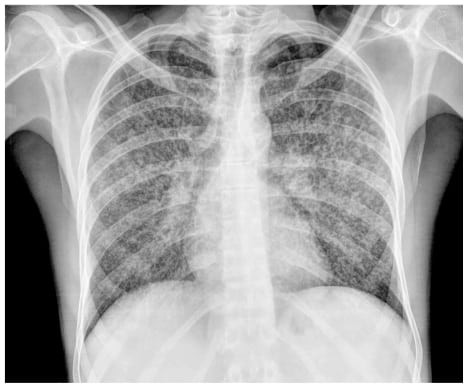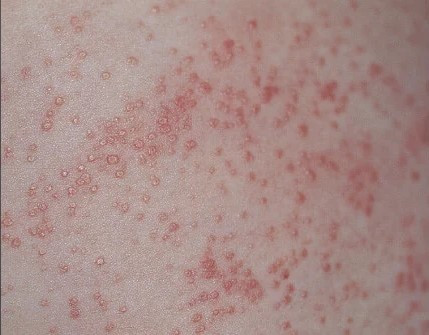Definisi
Miliaria apokrin merupakan kondisi peradangan kulit kronis (jangka panjang) yang diperkirakan terjadi ketika saluran keringat tersumbat atau meradang. Kondisi ini merupakan kondisi kronis dan kambuhan, yang dapat berlangsung sampai bertahun-tahun. Miliaria apokrin pertama kali ditemukan oleh George Henry Fox dan John Addison Fordye pada tahun 1902 dan lebih sering disebut dengan penyakit Fox-Fordyce.
Penyebab
Penyebab pasti miliaria apokrin masih belum diketahui. Sumbatan saluran kelenjar keringat yang disebabkan oleh penumpukan sel kulit mati pada folikel rambut diperkirakan merupakan mekanisme yang dapat menjelaskan terbentuknya miliaria.
Beberapa hal yang diperikarakan dapat menyebabkan miliaria apokrin adalah:
- Faktor keturunan. Meskipun miliaria apokrin biasanya tidak diturunkan, namun pada beberapa kasus yang jarang, miliaria apokrin dapat terjadi pada saudara kandung
- Miliaria apokrin umumnya muncul setelah pubertas. Penyakit ini jarang ditemui pada usia prepubertas dan post menopause. Adanya pengaruh hormon semakin didukung dengan adanya kekambuhan ketika menjelang menstruasi, serta perbaikan saat kehamilan, post menopaus, atau dengan pemakaian pil kontrasepsi
- Laser penghilang rambut. Miliaria apokrin dikatakan terjadi setelah prosedur laser untuk mengurangi rambut. Spekulasinya adalah radiasi dari laser menyebabkan kerusakan folikel rambut, yang diikuti dengan perubahan sel kulit mati sehingga sel ini menumpuk dan menyumbat kelenjar keringat. Selain itu, miliaria apokrin juga dapat timbul setelah beberapa sesi dari prosedur laser, sehingga dikatakan bahwa kerusakan termal (akibat panas) terhadap folikel rambut dapat menyebabkan miliaria apokrin
- Stress, berkeringat saat olahraga, cuaca panas dan lembap merupakan pencetus dari timbulnya gatal pada kulit. Gatal inilah yang dapat memicu timbulnya miliaria apokrin
- Keringat berlebih, yang dapat disebabkan oleh olahraga, iklim lembap, pakaian yang panas, aktivitas seksual, dan stress emosional. Hal ini menyebabkan kekambuhan.
Faktor Risiko
Mayoritas kasus miliaria apokrin terjadi pada wanita muda yang sudah pubertas. Sekitar 90% kasus miliaria apokrin ditemukan pada wanita usia 13 sampai 45 tahun (rata-rata usia 21 tahun). Rasio wanita dibandingkan pria adalah 9:1. Namun, ada juga miliaria apokrin yang timbul pada anak pre pubertas dan wanita post menopause, serta pada pria. Meskipun banyak studi yang menunjukkan bahwa tidak ada kecenderungan miliaria apokrin untuk timbul pada ras tertentu, namun beberapa mengatakan bahwa kondisi ini lebih sering ditemukan pada orang Yahudi.
Gejala
Miliaria apokrin bergejala gatal dan ruam. Saat saluran kelenjar keringat tersumbat, akan terjadi penumpukan material keringat yang harusnya keluar. Kelenjar keringat yang berada dalam kulit kemudian akan pecah sehingga isinya keluar ke jaringan kulit sekitarnya. Hal ini menyebabkan peradangan dan gatal yang intens. Gatal ini akan lebih intens ketika berkeringat, stress, cemas, serta pada malam hari sampai dapat mengganggu tidur. Namun, pada beberapa kasus bisa tidak menimbulkan keluhan gatal.
Gatal biasanya mendahului timbulnya ruam. Ruam atau bintik-bintik yang gatal pada kulit terutama ditemukan pada area tubuh yang kaya akan kelenjar keringat. Area tersebut adalah ketiak, sekitar putting susu, area kemaluan dan anus. Lokasi yang lebih jarang adalah pusar, bagian antara kelamin dan anus, dan bagian dalam dari paha. Area yang jarang terkena adalah bibir, dada, perut, dan tungkai. Biasanya miliaria apokrin timbul pada kedua sisi tubuh.
Karakteristik ruamnya sendiri adalah bintil-bintil banyak yang berukuran 2 sampai 3 milimeter, kencang, berbentuk seperti kubah, permukaan mengkilap, dengan warna yang bervariasi (warna kulit, kekuningan, kemerahan, merah muda, ungu muda). Jika bintil ini ditusuk akan mengeluarkan cairan berwarna kekuningan atau seperti susu.
Diagnosis
Dokter biasanya mendiagnosis miliaria aprokin berdasarkan hasil pemeriksaan fisik saja. Namun, dapat dilakukan pemeriksaan tambahan seperti:
- Pemeriksaan ini untuk melihat adanya ruam yang berada di folikel rambut, adanya rambut yang rusak, dan komedo
- Pemeriksaan biopsi terhadap bintil ruam akan menegakkan diagnosis miliaria aprokin secara pasti. Pemeriksaan ini biasanya dilakukan jika diagnosis miliaria apokrin masih belum pasti atau belum dapat ditegakkan dengan pemeriksaan di atas.
- High-definition optical coherence tomography imaging. Pemeriksaan radiologi ini dapat digunakan untuk kasus kecurigaan miliaria apokrin yang tidak berhasil ditegakkan dengan pemeriksaan biopsi
Tata Laksana
Pengobatan dan terapi miliaria apokrin cukup sulit dan dibatasi dengan kurangnya studi mengenai penyakit ini. Namun, terapi penting untuk mencegah efek buruk dari gatal yang intens. Terdapat beberapa pilihan terapi yang meliputi obat oles, obat minum, dan operasi.
Terapi pilihan pertama meliputi retinoid, benzoyl peroksida oles, klindamisin oles, kortikosteroid, penghambat kalsineurin oles, dan pil kontrasepsi. Obat-obatan ini menjadi pilihan pertama karena mudah didapatkan, pemberiannya mudah, dan memiliki efek samping serius yang minimal. Namun, regimen yang optimal belum diketahui. Kekambuhan juga dapat terjadi setelah pemberhentian terapi.
- Kortikosteroid oles potensi rendah merupakan pilihan terbaik (risiko penipisan kulit kecil). Krim ini biasanya digunakan dua kali sehari sampai gejala membaik lalu dapat diturunkan menjadi dua sampai tiga kali seminggu. Selain itu, bisa juga diberikan kortikosteroid minum atau yang disuntikan ke kulit yang terkena
- Klindamisin oles. Krim ini dipakai dua kali sehari selama 4 minggu dan biasanya perbaikan didapatkan pada beberapa minggu awal setelah pemakaian
- Benzoyl peroksida 5% oles. Obat ini bersifat antiseptik dan dapat dipakai setiap hari sampai 8 minggu
- Penghambat kalsineurin oles. Krim ini mengurangi peradangan tanpa risiko penipisan kulit. Contoh krim ini adalah pimekrolimus dan takrolimus yang dapat dipakai dua kali sehari selama 8 minggu, serta dapat digunakan sebagai maintenance.
- Retinoid oles. Baik tretinoin dan adapalen dapat digunakan. Kandungan ini diperkirakan dapat mengurangi sumbatan folikel dan sumbatan saluran kelenjar. Namun, krim ini dapat menyebabkan iritasi kulit. Jika terjadi iritasi, maka penggunaannya dapat dikurangi menjadi setiap 2 hari sekali
- Isotretinoin
- Obat anti alergi
Untuk penyakit yang berat atau tidak membaik dengan terapi awal, maka dapat diberikan terapi pilihan kedua yang meliputi:
- Operasi pengangkatan miliaria apokrin
- Laser fraksional
- Pulsed dye laser
- Toksin botulinum
- Fototerapi
- Elektrokoagulasi
- Dermabrasi
- Copper vapor
- Laser CO
- Liposucton-assisted-curettage
- Teknologi gelombang mikro
Meskipun begitu, kekambuhan sering terjadi setelah penghentian terapi.
Komplikasi
Pada miliaria apokrin yang sudah berlangsung lama (kronis), tampakannya dapat berbeda yaitu kulit menjadi menebal, kasar, dan gelap akibat garukan berulang. Sementara itu, pada kasus berat, dapat terjadi kerusakan kelenjar dan folikel rambut sehingga menyebabkan area kulit yang terkena menjadi tidak berkeringat serta memiliki sedikit rambut.
Miliaria aprokin dapat berlangsung sampai beberapa tahun. Pada beberapa kasus, dapat sembuh saat kehamilan. Beberapa orang juga mengalami perbaikan setelah menopause, sementara yang lain tetap mengalaminya meskipun sudah menopause.
Pencegahan
Untuk mencegah kekambuhan miliaria aprokin dapat dilakukan dengan menghindari tempat yang panas dan yang menyebabkan berkeringat. Selain itu, terapi hormonal juga dapat digunakan untuk pencegahan meskipun belum diketahui manfaatnya secara pasti.
Kapan Harus ke Dokter?
Jika Anda mengalami gejala miliaria apokrin, terutama gatal, sebaiknya Anda berkonsultasi ke dokter untuk mengontrol keluhan dan mencegah kekambuhan.
Mau tahu informasi seputar penyakit lainnya? Cek di sini, ya!
- dr Anita Larasati Priyono
UpToDate. Uptodate.com. (2022). Retrieved 11 May 2022, from https://www.uptodate.com/contents/fox-fordyce-disease-apocrine-miliaria.
Litchman, G., & Sonthalia, S. (2022). Apocrine Miliaria. Ncbi.nlm.nih.gov. Retrieved 12 May 2022, from https://www.ncbi.nlm.nih.gov/books/NBK545207/.
Fox-fordyce disease | DermNet NZ. Dermnetnz.org. (2022). Retrieved 12 May 2022, from https://dermnetnz.org/topics/fox-fordyce-disease.
Alikhan, A., & Flores, S. (2022). Fox-Fordyce Disease (Apocrine Miliaria). Dermatology Advisor. Retrieved 12 May 2022, from https://www.dermatologyadvisor.com/home/decision-support-in-medicine/dermatology/fox-fordyce-disease-apocrine-miliaria/.
Fox-Fordyce Disease Treatment & Management: Medical Care, Surgical Care, Consultations. Emedicine.medscape.com. (2022). Retrieved 12 May 2022, from https://emedicine.medscape.com/article/1070560-treatment#d4.









